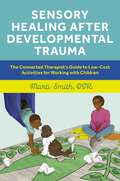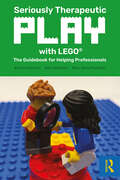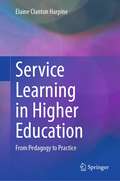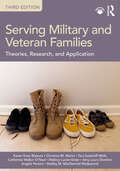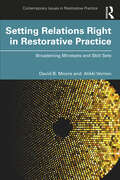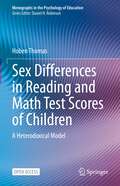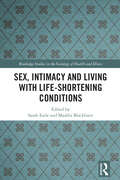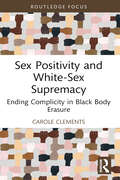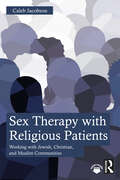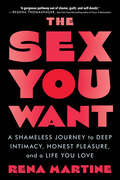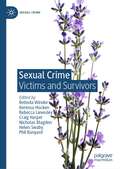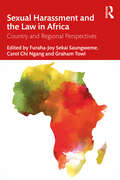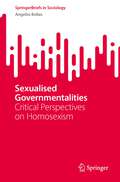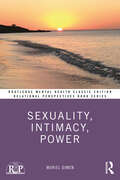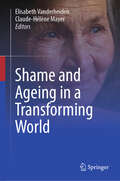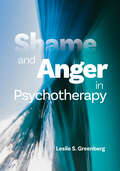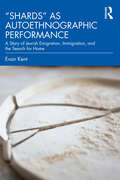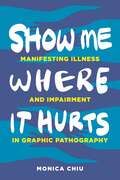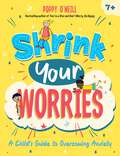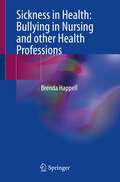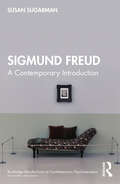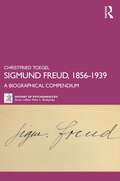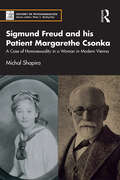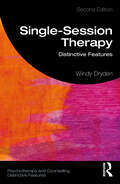- Table View
- List View
Sensory Healing after Developmental Trauma: The Connected Therapist’s Guide to Low-Cost Activities for Working with Children
by Marti SmithIn using this resourceful guide, therapists can develop a comprehensive understanding of how trauma impacts their young clients' brains and sensory systems. Filled with therapeutic strategies and activities tailored to specific regions of the brain, professionals will be able to optimise brain rehabilitation and improve sensory processing abilities.The book includes a wide range of low-cost, budgeted activities that can be applied in a variety of settings, including juvenile justice, rehab, schools, homes, residential care, and foster homes, all of which include guidance on how to engage the wider community in order to maximise the potential for healing.Complete with the latest research on trauma and real-life case studies, this book provides an excellent foundation on understanding the science and applying it in practice. It is an indispensable resource for paediatric caregivers looking to support the children they're working with in healing the impact of trauma.
Seriously Therapeutic Play with LEGO®: The Guidebook for Helping Professionals
by Kristen Klassen Alec Hamilton Mary Anne PeabodyLEGO® bricks are a staple in many child and play therapists’ offices, and Seriously Therapeutic Play with LEGO® shows therapists and counselors how to integrate LEGO® in a therapeutically valuable way. This book presents a therapeutic approach based in biological, psychological, and social research, one that supports participants as they build models that represent their thoughts, emotions, experiences, and reflections. Using a variety of evidence-based intervention techniques, chapters show clinicians how to incorporate the model and associated metaphors to help clients, and they do so in a way that is compatible with any number of therapeutic orientations or perspectives. Though based in current research, Seriously Therapeutic Play with LEGO® is designed for psychologists, social workers, school counselors, occupational therapists, clinical educators and supervisors, coaches, support workers, and other health care providers across the lifespan who wish to use play therapeutically.
Seriously Therapeutic Play with LEGO®: The Guidebook for Helping Professionals
by Kristen Klassen Alec Hamilton Mary Anne Peabody• There is a dearth of research regarding use of LEGO® in therapy and this manuscript presents the foundational response to that gap.• Most available approaches to using LEGO® in therapy are prescriptive and directive; this book presents an innovative, responsive, and dynamic approach to the use of LEGO®.• Practitioner-focused, presenting practical information and relevant vignettes that can be readily implemented in therapy.
Service Learning in Higher Education: From Pedagogy to Practice
by Elaine Clanton HarpineThis practical guide assists university faculty in developing and implementing service-learning courses and projects across multiple disciplines. It examines how embedding academic service-learning projects into the core curricula benefits not only the students, but also their universities and communities. The book describes ways in which service learning becomes a powerful teaching method using step-by-step explanations, real-world examples, and instructor checklists and handouts. Chapters detail how to integrate academic service-learning projects into classroom pedagogy and evaluate student experience.Key areas of coverage include:Strategies for ensuring that students engage with academic service-learning projects from the initial stages through completion.Guidance on embedding an academic service-learning curriculum into traditional coursework to supplement students’ textbook knowledge and classroom experiences to address real-world problems in the community.Research confirming the ways in which students learn more and score higher on end-of-the-semester tests when courses incorporate academic service-learning projects.Steps to incorporate service-learning projects across various disciplines and coursework to enrich student learning and produce positive outcomes for universities and communities. Service Learning in Higher Education is an essential resource for professors and graduate students as well as teachers and educational professionals in such varied fields as school and clinical child psychology, educational psychology, social work, pedagogy, educational practice and policy, sociology, anthropology, and all related disciplines.
Serving Military and Veteran Families: Theories, Research, and Application
by Karen Rose Blaisure Christina M. Marini Tara Saathoff-Wells Catherine Walker O’Neal Mallory Lucier-Greer Amy Laura Dombro Colonel Angela Pereira Shelley M. MacDermid WadsworthServing Military and Veteran Families introduces readers to the unique culture of military families, their resilience, and the challenges of military life. It reviews the latest research, theories, policies, and programs to prepare readers for understanding and working with military and veteran families. It also offers practical knowledge about the challenges that come with military family life and the federal policies, laws, and programs that support military and veteran families. Boasting a new full-color design and rich with pedagogy, the text also includes several boxed elements in each chapter. "Spotlight on Research" highlights researchers who study military and veteran families with the goal of informing and enriching the work of family support professionals. "Voices from the Frontline" presents the real-life stories of support program leaders, practitioners, researchers, policymakers, and most importantly service members and veterans and their families. "Tips from the Frontline" offers concrete, hands-on suggestions based on the experiences and wisdom of the people featured in the text and the broader research and practice communities. Third Edition features: Streamlined focus on theories and the addition of the contextual model of family stress and life course theory, including an interview with Glen Elder in which he shares his perspective on the development of life course theory and how it can be applied to understand development across individuals and cohorts. Personal accounts of 70 program leaders, practitioners, researchers, policymakers, and, significantly, service members, veterans, and family members who offer insight into their personal experiences, successes, and challenges associated with military life. 20 new interviews with service members, veterans, family members, researchers, and clinicians that bring important topics to life. Updated demographics and descriptions of service members, veterans, and their families. Expanded descriptions of mental health treatment approaches with an emphasis on including family members. Updated exercises focused on providing services to military and veteran families. New online resources designed to further enrich discourse and discussion. Serving Military and Veteran Families is designed as a core text for advanced undergraduate or graduate courses on military and veteran families, or as a supplement for related courses taught in family science, human development, family life education, social work, and clinical or counseling psychology programs. Providing a foundation for working with increased sensitivity, knowledge, and respect, the text can also be a useful resource for helping professionals who work with military and veteran families.
Setting Relations Right in Restorative Practice: Broadening Mindsets and Skill Sets (Contemporary Issues in Restorative Practice)
by David B. Moore Alikki VernonSetting Relations Right in Restorative Practice is a practical guide to using restorative processes, both in justice systems, to provide a healing response to harm, and in broader community contexts, to help people co-exist peacefully. Restorative processes can help to establish, maintain, deepen, and repair relationships, and to neutralise the conflict associated with negative relationships. The result is less conflict within people, between people, and between groups, and increasing individual and community wellbeing. These complex goals can be distilled to the single principle of setting relations right. The authors distil lessons from their decades of work at the frontline of restorative innovation. They outline an accurate, accessible theory that informs a restorative mindset, and describe in detail the corresponding skill set. Succinct, engaging case studies include refinements to existing programs in justice systems. Other case studies include the innovations of restorative responses to institutional abuse and to family violence and sexual harm, initiatives to increase psychological safety in schools and workplaces, and programs that support restorative ways-of-working across whole cities or regions. By applying elements from successful programs, practitioners can realise the broader reforming potential of restorative practice. This book is essential reading for restorative practitioners, administrators, and policymakers, for students and researchers – indeed, for anyone interested in the power and potential of restorative practice and other forms of deliberative decision-making.
Sex Differences in Reading and Math Test Scores of Children: A Heterodoxical Model (Monographs in the Psychology of Education)
by Hoben ThomasThis open access book examines why reading and math test scores for boys and girls have differed since the origins of testing in the United States. It details the pattern of differences that have remained largely unchanged for more than 100 years in the United States and worldwide. The book explores why boys have modestly larger math test score means than girls, and why girls have far larger reading test score means than boys. Boys have larger test score variances for both tasks. The only data of focus—and thus the only data to be explained—are boys’ and girls’ test score sample means and variances. In addition, the book provides the only coherent theory of gender differences explaining math and reading test score means and variances obtained in observational settings. It develops the simple genetical idea framed within a finite probability mixture model; it provides parameter estimates and displays numerous estimated probability distributions associated with the selected accessible studies chosen for analysis; and it extends the theory and provides explanations for never understood puzzling features of test score data. The book requires no auxiliary sources, although some understanding of random variables and probability theory is required to follow the formalization. It contains all technical details, including the estimation procedure and an R code implementation. Key areas of coverage include: · Extensive literature summary from a unique data inequalities perspective. · Perspective that challenges existing viewpoints on sex differences, falsifying conventional perspectives. · Illustrates probability modeling of psychological data. · Illustrates the failure of conventional statistics to explain data and the need for modeling data. Sex Differences in Reading and Math Test Scores of Children is an invaluable resource for researchers, professors, and graduate students in educational psychology, teaching and teacher education, literacy / language teaching and learning, mathematics education, curriculum studies, developmental psychology, statistics, and all interrelated disciplines.
Sex, Intimacy and Living with Life-Shortening Conditions
by Sarah Earle Maddie BlackburnThis multi-disciplinary and inclusive collection brings together theoretically informed and empirically focused research on sex, intimacy and reproduction in relation to young people and adults with life-shortening conditions. Advances in healthcare mean that increasing numbers of young people with life-shortening conditions are transitioning into adulthood. Issues such as sex and intimacy, dating and relationships, fertility and having children are increasingly relevant to them and to the people that support them, including families, carers, practitioners and professional education, health and social care agencies. This three-part book explores the relevance and significance of this field, examines everyday experiences, and highlights the challenges faced by individuals and organisations in addressing the needs of such people in daily life and in the context of practice. Drawing on perspectives from sociology, disability studies, epidemiology, health policy, psychotherapy, legal studies, queer studies and nursing, this ground-breaking volume is written by academics, policy makers, practitioners and experts by experience. It is an essential read for all those practising and researching in the fields of sexuality, chronic illness and disability and transition.
Sex Positivity and White-Sex Supremacy: Ending Complicity in Black Body Erasure (Leading Conversations on Black Sexualities and Identities)
by Carole ClementsThis text critically examines, argues, and demonstrates how the sex-positive movement is complicit in the perpetuation of White Supremacy and anti-black bias in the field of human sexualities, offering white sexuality professionals embodied ethical antiracist strategies for sexual inclusion and transformational change. In a world where whiteness is considered the sexual and bodily norm, Carole Clements proposes that the sex-positive movement has failed to examine how it maintains White Supremacy through the guise of inclusivity, and how the lack of a critical understanding of what "sex-positive" means has caused harm to black, indigenous, and people of color (BIPOC) individuals and communities alike. Pivoting away from a sex-positive/sex-negative binary, this book establishes a sex-critical discourse by introducing and operationalizing the term "White-sex Supremacy" to produce a racially just and embodied sexual ethic. Chapters begin by looking at sexual science and its racial origins, recounting how both the science of sex and that of race strived for positivist legitimacy in the same historical moment. Moving from the social construction of racial and sexual hierarchies, chapters look at eugenics and sexology’s early "sex-positive" pioneers, such as Margaret Sanger and Havelock Ellis, before examining the establishment of a race-evasive yet distinctly white sexual normality reliant on sex-positive framing. It shows how sex positivity became a popularized term without a clear definition other than "good," and how the legacy of white fragility leads to complicit white silence and the erasure of Black sexualities. Theoretical, practical, and accessible, it offers tangible methods for white sexuality professionals and scholars to learn accompliceship (over allyship) to promote antiracist sexual justice activism. This book is essential reading for white sexuality professionals, including sex educators, sex therapists, marriage and family therapists, licensed professional counselors, psychotherapists, gynecologists, and nurses, who are committed to examining their whiteness in the context of their commitment to sex positivity.
Sex Therapy with Religious Patients: Working with Jewish, Christian, and Muslim Communities
by Caleb JacobsonSex Therapy with Religious Patients is a comprehensive guidebook for mental health professionals who work with those struggling with sexual issues within a religious context. The book provides practical guidance on how to approach sensitive topics related to sex and religion, including addressing religious beliefs and values that may impact sexual behavior, beliefs, and attitudes.Drawing on research and clinical experience, the book offers a range of evidence-based interventions for working with individuals from different Jewish, Christian, and Muslim backgrounds. It also explores the unique challenges and opportunities presented by patients’ religious beliefs and provides strategies for integrating spirituality into the therapeutic process.The book is written in an accessible and engaging style, with real-life case examples and exercises that can be used in therapy sessions. It is an essential resource for mental health professionals seeking to enhance their skills in working with religious individuals who are seeking sex therapy.
The Sex You Want: A Shameless Journey to Deep Intimacy, Honest Pleasure, and a Life You Love
by Rena MartineYou Deserve Great SexWhen it comes to relationships, our society has plenty of expectations. We're supposed to know how to speak up for ourselves in bed, be caring partners, and, of course, love ourselves first. But no one tells us how to actually do all those things, and we are left feeling unsatisfied, confused, and ashamed when we don't measure up.Former Deputy District Attorney Rena Martine was in that position. After rejecting the ideal white-picket fence life, she embarked on a journey to redefine intimacy in a way that felt true. In the years that followed, Rena defied all of society's sexual norms, built a presence as a global women's intimacy coach, and created the intimate life she craved.Now she brings those experiences to you! With no-holds-barred honesty, stories from real-life women, and sparkling humor, THE SEX YOU WANT will help you:Build a secure relationship with your most important partner—YOURSELFGet in touch with YOUR expectations for relationships so you can date more intentionallyDemystify lifestyle practices outside of the heterosexual-monogamous-vanilla box with frank discussions of female sexual fluidity, kink, and ethical non-monogamyFind apps, products, and communities to satisfy any curiosityBring deep intimacy and exciting variety into your bedroom and beyondWhen it comes to intimacy, vulnerability, and connection, you'll find that no two women are alike. THE SEX YOU WANT replaces cookie-cutter advice with powerful self-discovery tools to help you make friends with your own confidence and curiosity, build rock-solid relationships, and embrace what YOU love!
Sexual Crime: Victims and Survivors (Sexual Crime)
by Belinda Winder Kerensa Hocken Rebecca Lievesley Craig Harper Nicholas Blagden Helen Swaby Phil BanyardThis book offers an original contribution drawing together literature, research, practitioner and service user perspectives around the victimology of sexual crime and offending. Texts about sexual crime focus on the perpetration of sexual crime. This is important as, if we know how, why and in what situations people commit abuse, it will help us prevent further suffering. However, it is important that the voices of people who have experienced sexual abuse are heard and understood, as there is much we can learn from them - not simply about their experiences but improving our knowledge of victimisation also informs how we prevent sexual crime.
Sexual Harassment and the Law in Africa: Country and Regional Perspectives
by Furaha-Joy Sekai Saungweme Carol Chi Ngang Graham TowlWritten by a team of experts from legal, forensic, and policy backgrounds, this book presents new research into sexual violence and harassment across Africa.This first of it's kind book foregrounds the work of African scholars and presents careful research analysis and case studies that consider sexual harassment from legal, socio-economic, and cultural realities. It highlights the importance of laws around sexual harassment in Africa, the intersectional challenges it poses to women in the workplace, and the role of the feminist movement in Africa to hold perpetrators accountable and give voice to survivors of sexual harassment. The book forms part of a broader African-driven research initiative on sexual harassment and the law and is written in partnership with the Africa End Sexual Harassment Initiative (AESHI). It also explores the need to focus on best-practice benchmarks for Africa and also learning from developments in Africa.Timely and relevant, the book will be of great interest to legal and policy academic scholars, professionals, and activists working in the fields of gender policy, forensic psychology, and NGOs. It will also be useful reading for postgraduate students of law, gender studies, political science, and African studies.
Sexualised Governmentalities: Critical Perspectives on Homosexism (SpringerBriefs in Sociology)
by Angelos BollasThis book critically examines the concept of sexualised governmentalities, a framework for understanding the evolving discourse and power dynamics surrounding discrimination on the basis of sexual practices. Central to this exploration is the shift from traditional heteronormative perspectives to a more complex hetero/homonormative context, where the structure and organisation of sexual relationships gain prominence over the gender or sexual orientation of the participants. A key focus of the book is the concept of homosexism within the realm of gay masculinity studies. The author discusses homosexism as a form of discrimination experienced by gay men from other gay men, highlighting the influence of heteronormative patriarchal society on these interactions. It calls for a broader recognition and acceptance of diverse sexual expressions and challenges the reader to re-evaluate the societal norms around masculinity and sexual behaviour. Sexualised Governmentalities is an important contribution to the discourse on sexual identity and practice, offering insights for a more inclusive and empathetic understanding of sexual diversity.
Sexuality, Intimacy, Power: Classic Edition (Relational Perspectives Book Series)
by Muriel DimenThis book offers Dimen’s classic take on psychosexuality, drawing on relational theory, feminism and postmodernism, with a new foreword by Virginia Goldner and Velleda Ceccoli honouring the late Muriel Dimen and introducing a new audience to her profound legacy. For Dimen, the shift from dualism to multiplicity that has reshaped a range of disciplines can also be brought to bear on our thinking about sexuality. She urges us to return to the open-mindedness hiding between the lines and buried in the footnotes of Freud’s writings, and to replace the determinism into which his thought has hardened with more fluid notions of contingency, paradox, and thirdness. By unveiling the colloquy among psychoanalysis, social theory, and feminism, Dimen challenges clinicians and academicians alike to rethink ideas about gender, eroticism, and perversion. She explores, among other topics, the relations between lust and libido; the limitations of Darwinian thought in theorizing homosexuality; the body as projective test; and the intimate tangle of love and hate between women. Generous clinical examples illustrate the ways in which a radical re-visioning of psychosexuality benefits therapists and patients alike. A brilliant example of contemporary psychoanalytic theory at its destabilizing best, Sexuality, Intimacy, Power covers both clinical insights and theoretical rethinking that is invaluable for psychoanalysts, psychotherapists, and students of women’s, gender and queer studies.
Shame and Ageing in a Transforming World
by Elisabeth Vanderheiden Claude-Hélène MayerThe book provides a comprehensive overview of research and concepts related to shame and ageing, in the context of social change, upheavals and paradigm shifts, from transdisciplinary, cultural and transcultural perspectives. Drawing upon the editors' previous works on the topic of shame, this volume discusses the contexts of shame and ageing from theoretical, conceptual, and empirical perspectives. The toxic and stressful aspects of shame have been the focus of scientific analysis and discourse on shame and ageing. This volume explicitly makes the dimensions of shame a resource for individuals, and collective transformation processes the object of research in the context of ageing. It looks at emerging lifestyle, political, socio-economic and health contexts. It looks at how and why the frequency, intensity and handling of feelings of shame change over the course of life; the impact of shame on emotional well-being and mental health of older people; the impact of shame on social relationships and social engagement of older people in different cultures; the role of cultural values and norms in the development and processing of feelings of shame, especially in older people, and how these can be used for self-development; and the differences in the way older people in different cultures deal with feelings of shame and the way these can be used to develop effective strategies and techniques for older people to cope with shame. The editors and contributors thereby take cultural and gender aspects, as well as positive psychology and resource-orientated concepts, such as salutogenesis, resilience, happiness, fortitude, locus of control, faith- or strengths-based approaches into account and contextualize them against processes of social upheaval and transformation.
Shame and Anger in Psychotherapy
by Leslie S. GreenbergThis book examines shame and anger, their relationship with one another, and how mental health providers can work with each of them to produce therapeutic change. Although very different emotions, shame and anger are highly related in therapy. Because shame and anger have both adaptive and maladaptive forms, intervention differs depending on what type of shame or anger is being experienced and in what sequence they occur. Therapists need to consider the type of shame or anger they are dealing with and how the two emotions interact before they can make process diagnoses of what is occurring at different moments in a session. This book emphasizes the benefits of accessing and experiencing shame and anger viscerally to promote emotion change in therapy. It teaches therapists how to help clients access their shame or anger in a safe therapeutic setting to make this emotion amenable to transformation, and create new narratives based on the transformed feelings.
"Shards" as Autoethnographic Performance: A Story of Jewish Emigration, Immigration, and the Search for Home
by Evan Kent"Shards" as Autoethnographic Performance explores the development, creation, and presentation of performed autoethnography. The author shares the impetus for the work’s creation and his method for writing and rehearsing performed autoethnography. This book is essentially an autoethnography about writing and performing an autoethnography and functions as a "play within a play." Through extensive discussions about the development, writing, and performance of "Shards," the author reveals how contemporary political events and social issues as well as events in his ancestors’ history impact his writing, research, and eventual performance. The author takes us on an autoethnographic journey encompassing early 20th-century immigration from Eastern Europe to the United States, his personal development as a singer and actor, the practically obsessive need to perform, his education and eventual employment as a cantor in a synagogue, and how he negotiates these personal and artistic conflicts. Throughout the book, Evan shares with the reader highly personal stories of great honesty, sincerity, and candor. The book also provides insight into performing during the COVID-19 pandemic and how performing artists (including the author) utilized online performing venues. This book would be a good companion volume for classes in qualitative research, autoethnography, and performance studies, as well as for those looking for a guide on writing, rehearsing, and performing solo theatre.
Show Me Where It Hurts: Manifesting Illness and Impairment in Graphic Pathography (Graphic Medicine)
by Monica ChiuIn Show Me Where It Hurts, Monica Chiu argues that graphic pathography—long-form comics by and about subjects who suffer from disease or are impaired—re-vitalizes and re-visions various negatively affected corporeal states through hand-drawn images. By the body and for the body, the medium is subversive and reparative, and it stands in contradistinction to clinical accounts of illness that tend to disembody or objectify the subject.Employing affect theory, spatial theory, vital materialism, and approaches from race and ethnic studies, women and gender studies, disability studies, and comics studies, Chiu provides readings of recently published graphic pathography. Chiu argues that these kinds of subjective graphic stories, by virtue of their narrative and descriptive strengths, provide a form of resistance to the authoritative voice of biomedicine and serve as a tool to foster important change in the face of social and economic inequities when it comes to questions of health and healthcare. Show Me Where It Hurts reads what already has been manifested on the comics page and invites more of what demands expression.Pathbreaking and provocative, this book will appeal to scholars and students of the medical humanities, comics studies, race and ethnic studies, disability studies, and women and gender studies.
Shrink Your Worries: A Child's Guide to Overcoming Anxiety
by Poppy O'NeillA worry-busting guide to help 7+-year-oldsEncourage your child to listen to their feelings, practise positive thinking and overcome their fears with this sensitive and supportive book. Bursting with activities, handy tips and simple exercises, Shrink Your Worries is the self-care companion every stress-prone child needs.
Sickness in Health: Bullying in Nursing and other Health Professions
by Brenda HappellThis book informs students and practitioners of the health professions about workplace bullying and how to recognise it. The health professions have among the highest rates of bullying of any occupational group. This book shines a light on bullying and its very real human consequences for health professionals. Statistics about bullying in health present a disturbing picture. However, they don't convey the human impact on people who only want to do good for others. The author begins by telling how her experiences spurred her to write this book and then introduces the champions, twelve health professionals who contributed their stories. The book starts with the champions' decision to become a health professional, and then describes their bullying experiences, the impact on almost every aspect of their lives and careers, and how they tried to resolve or deal with the bullying. Some were still dealing with bullying, and all felt they had been forever changed by their experiences.The stories show that bullying is much more than the actions of a few, it is deeply embedded in the culture of institutions responsible for providing quality health care. Better preparation for leadership positions and independent processes for reporting unacceptable behaviours and actions are two suggestions for tackling bullying and its consequences. This book shows the necessity to expose these appalling behaviours and their human costs in order to address workplace bullying and create a healthy and safe environment for everyone in healthcare. This volume is aimed at undergraduate and postgraduate students, and practitioners of nursing and other health professions, the general public and other stakeholders of health services. It will enhance their understanding of, ability to recognise, and strategies to cope with, workplace bullying.
Sigmund Freud: A Contemporary Introduction (Routledge Introductions to Contemporary Psychoanalysis)
by Susan SugarmanIn this clear and concise volume, Susan Sugarman introduces the work of Sigmund Freud and keenly illustrates the impact his pioneering contributions have had on the way we think about ourselves and each other. Part of the Routledge Introductions to Contemporary Psychoanalysis series, this book sees Sugarman offer a comprehensive overview of Freud’s major theories, their clinical application, and their empirical reach. She highlights the ways in which his work is commonly misinterpreted and expertly guides the reader through his key publications on not only his general theory but also neuroses, dreams, ordinary waking mental life, and civilization and society. Considering Freud’s body of work as a whole, she explores the observations and reasoning that led him to the questions he raised and the conclusions he reached, showing the rich and nuanced approach in his writing. Sigmund Freud: A Contemporary Introduction is an essential read for psychoanalysts, both in practice and in training, as well as students and scholars looking to understand the legacy of Freud’s work.
Sigmund Freud, 1856-1939: A Biographical Compendium (The History of Psychoanalysis Series)
by Christfried ToegelSigmund Freud, 1856–1939 draws on a wide range of primary sources to present all the datable events that took place in Sigmund Freud’s life, shining new light on his day-to-day experiences. Christfried Toegel’s work provides details and context for the personal, social and political conditions under which Freud developed his theories during this time period. The book’s timeline presents not only significant events but also the small and everyday interactions and experiences in Freud’s life. Drawn from sources including Freud’s calendars, notebooks, travel journals and lists of fees, letters and visits, this unique book provides unparalleled insight into his work.Sigmund Freud, 1856–1939 will be of great interest to psychoanalysts in practice and in training, as well as academics and scholars of Freud, psychoanalytic studies, the history of science and the history of Europe.
Sigmund Freud and his Patient Margarethe Csonka: A Case of Homosexuality in a Woman in Modern Vienna (History of Psychoanalysis)
by Michal ShapiraThis book provides a historical analysis of one of Sigmund Freud’s least-studied cases, published in 1920 as The Psychogenesis of a Case of Homosexuality in a Woman. Scholars of sexuality often focus on Freud’s writings on male homosexuality, disregarding his views on homosexual women. This book serves as a corrective, renewing and reinvigorating interest in Freud, and demonstrating that his views on sexuality are as relevant today as ever. Part I introduces the case and explores Freud’s attitudes towards lesbianism, radical among his medical colleagues in the early twentieth century. It also puts Margarethe Csonka, the patient, at its centre. Michal Shapira considers Freud’s only treatment of a "female homosexual" and assesses Csonka’s background life before and after the encounter. Part II expands the case beyond the scientific-medical purview of the times and looks at the new opportunities afforded to women and assimilated Jews through growing equality and the modernization of urban life in 1920s Vienna. This book places Csonka’s case within the broader context of medical and psychological texts, Freud’s own writings, Jewish and queer history, and modern Vienna’s urban and art history. Sigmund Freud and his Patient Margarethe Csonka will be of great interest to psychoanalysts in practice and in training, and to readers interested in the history of gender and sexuality, feminism, modern European and urban history, the history of psychoanalysis, science and medicine, and the history of ideas.
Single-Session Therapy: Distinctive Features (Psychotherapy and Counselling Distinctive Features)
by Windy DrydenThe new edition of Single-Session Therapy: Distinctive Features provides an up-to-date general introduction to the field of Single-Session Therapy (SST). Written by eminent clinician and author Windy Dryden, this book challenges mainstream therapeutic assumptions, predicated on the certainty that clients will have more than one therapy session. Following the popular Distinctive Features format, the book is divided into two sections, with 15 chapters describing theoretical features and 15 offering practical techniques of SST. Updates to the revised edition include new chapters on the importance of the working alliance in SST, on different types of help that clients seek from SST and on common errors in SST and how to avoid them. Single-Session Therapy will be of interest to those across the psychotherapy and counselling professions and will provide extensive guidance for students, trainees and practitioners alike.
